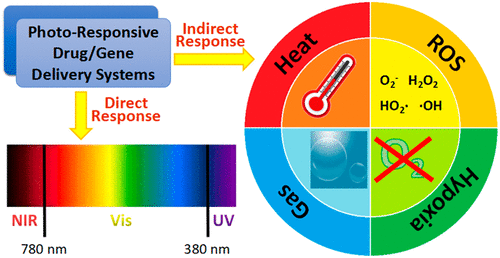当前位置:
X-MOL 学术
›
Biomacromolecules
›
论文详情
Our official English website, www.x-mol.net, welcomes your
feedback! (Note: you will need to create a separate account there.)
Photoresponsive Drug/Gene Delivery Systems
Biomacromolecules ( IF 5.5 ) Pub Date : 2018-04-27 00:00:00 , DOI: 10.1021/acs.biomac.8b00422 Yang Zhou 1 , Huan Ye 1 , Yongbing Chen 2 , Rongying Zhu 2 , Lichen Yin 1
Biomacromolecules ( IF 5.5 ) Pub Date : 2018-04-27 00:00:00 , DOI: 10.1021/acs.biomac.8b00422 Yang Zhou 1 , Huan Ye 1 , Yongbing Chen 2 , Rongying Zhu 2 , Lichen Yin 1
Affiliation

|
Light as an external stimulus can be precisely manipulated in terms of irradiation time, site, wavelength, and density. As such, photoresponsive drug/gene delivery systems have been increasingly pursued and utilized for the spatiotemporal control of drug/gene delivery to enhance their therapeutic efficacy and safety. In this review, we summarized the recent research progress on photoresponsive drug/gene delivery, and two major categories of delivery systems were discussed. The first category is the direct responsive systems that experience photoreactions on the vehicle or drug themselves, and different materials as well as chemical structures responsive to UV, visible, and NIR light are summarized. The second category is the indirect responsive systems that require a light-generated mediator signal, such as heat, ROS, hypoxia, and gas molecules, to cascadingly trigger the structural transformation. The future outlook and challenges are also discussed at the end.
中文翻译:

光敏药物/基因递送系统
可以根据照射时间,部位,波长和密度来精确控制作为外部刺激的光。因此,越来越多地追求光响应性药物/基因递送系统并将其用于药物/基因递送的时空控制以增强其治疗功效和安全性。在这篇综述中,我们总结了光响应药物/基因传递的最新研究进展,并讨论了传递系统的两个主要类别。第一类是直接响应系统,其在载体或药物本身上发生光反应,并且总结了对紫外线,可见光和近红外光有响应的不同材料以及化学结构。第二类是间接响应系统,需要光产生的介体信号,例如热量,ROS,缺氧和气体分子,逐步触发结构转型。最后还将讨论未来的前景和挑战。
更新日期:2018-04-27
中文翻译:

光敏药物/基因递送系统
可以根据照射时间,部位,波长和密度来精确控制作为外部刺激的光。因此,越来越多地追求光响应性药物/基因递送系统并将其用于药物/基因递送的时空控制以增强其治疗功效和安全性。在这篇综述中,我们总结了光响应药物/基因传递的最新研究进展,并讨论了传递系统的两个主要类别。第一类是直接响应系统,其在载体或药物本身上发生光反应,并且总结了对紫外线,可见光和近红外光有响应的不同材料以及化学结构。第二类是间接响应系统,需要光产生的介体信号,例如热量,ROS,缺氧和气体分子,逐步触发结构转型。最后还将讨论未来的前景和挑战。











































 京公网安备 11010802027423号
京公网安备 11010802027423号